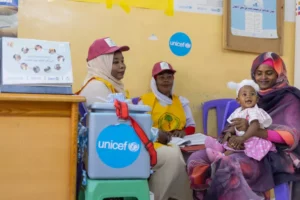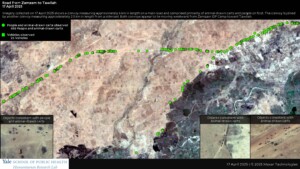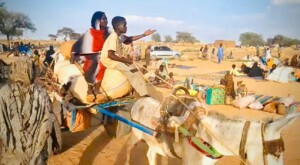Humanitarians find 23,000 displaced in Sudan’s Blue Nile
Approximately 23,000 people displaced by insecurity in Blue Nile state have moved to five locations in Ed Damazin, El Roseires, and Bau localities. They are living in temporary shelters alongside other communities.
A large group of displaced from seven villages in Bau, amounting to 9,300 people, now lives in El Azaza, just east of Ed Damazin. An estimated 6,700 people from thirteen villages in Geissan and Bau have moved to El Gerri, east of El Azaza, in April this year.
The joint mission of humanitarian aid partners found that in El Roseires locality, approximately 3,500 people left their homes in Sheneisha, north of Ed Damazin, and settled in a nearby open area close to the river. The host community there shared water, food, and shelter materials, the UN humanitarian office (OCHA) reported in its latest weekly bulletin.
In Bau, about 3,100 people were displaced from Derang and have moved to a village called Shahid Afandi. These people have received some assistance from local NGOs. An estimated 300 displaced people have moved from Midyam area to Harun El Mahata. Most of these people are farmers.
Food is a major need of the displaced people, according to the humanitarian mission. The displaced were found living in temporary housing, at times in cramped spaces. They told the mission that they will remain in the areas until stability is established in their home areas.
A mission of the World Food Programme, the government’s aid commission (HAC), the Sudanese Red Crescent Society (SRCS), national NGOs, and OCHA – set-up to assess the food situation of the displaced people in Blue Nile – reported the displacement numbers.
‘Forcibly displaced’
An estimated 24,500 people had fled Bau locality by 2 July, according to OCHA. The Sudanese humanitarian organisation Faida and the Blue Nile Centre for Human Rights and Peace Studies have accused Sudanese army forces of forcibly relocating people living in Bau and Geissan localities to a camp near Ed Damazin.
In May, the UN Resident and Humanitarian Coordinator in Sudan ad interim, Geert Cappelaere, already expressed his deep concern about the reports of large-scale displacement, including possible forced relocations, taking place in Blue Nile state.
Several villages in Sudan’s Blue Nile state were bombed by the Sudanese Air Force in Bau and El Kurmuk localities in September. That month the Sudan People’s Liberation Movement-North (SPLM-N) claimed victory over a large number of military forces and pro-government militia members during a battle at Mount Kilgo, between Bau and Ed Damazin.
Approximately 23,000 people displaced by insecurity in Blue Nile state have moved to five locations in Ed Damazin, El Roseires, and Bau localities. They are living in temporary shelters alongside other communities.
A large group of displaced from seven villages in Bau, amounting to 9,300 people, now lives in El Azaza, just east of Ed Damazin. An estimated 6,700 people from thirteen villages in Geissan and Bau have moved to El Gerri, east of El Azaza, in April this year.
The joint mission of humanitarian aid partners found that in El Roseires locality, approximately 3,500 people left their homes in Sheneisha, north of Ed Damazin, and settled in a nearby open area close to the river. The host community there shared water, food, and shelter materials, the UN humanitarian office (OCHA) reported in its latest weekly bulletin.
In Bau, about 3,100 people were displaced from Derang and have moved to a village called Shahid Afandi. These people have received some assistance from local NGOs. An estimated 300 displaced people have moved from Midyam area to Harun El Mahata. Most of these people are farmers.
Food is a major need of the displaced people, according to the humanitarian mission. The displaced were found living in temporary housing, at times in cramped spaces. They told the mission that they will remain in the areas until stability is established in their home areas.
A mission of the World Food Programme, the government’s aid commission (HAC), the Sudanese Red Crescent Society (SRCS), national NGOs, and OCHA – set-up to assess the food situation of the displaced people in Blue Nile – reported the displacement numbers.
‘Forcibly displaced’
An estimated 24,500 people had fled Bau locality by 2 July, according to OCHA. The Sudanese humanitarian organisation Faida and the Blue Nile Centre for Human Rights and Peace Studies have accused Sudanese army forces of forcibly relocating people living in Bau and Geissan localities to a camp near Ed Damazin.
In May, the UN Resident and Humanitarian Coordinator in Sudan ad interim, Geert Cappelaere, already expressed his deep concern about the reports of large-scale displacement, including possible forced relocations, taking place in Blue Nile state.
Several villages in Sudan’s Blue Nile state were bombed by the Sudanese Air Force in Bau and El Kurmuk localities in September. That month the Sudan People’s Liberation Movement-North (SPLM-N) claimed victory over a large number of military forces and pro-government militia members during a battle at Mount Kilgo, between Bau and Ed Damazin.
Related articles:
'Sudan continues to displace people in Blue Nile': human rights centre (13 July 2015)











 and then
and then